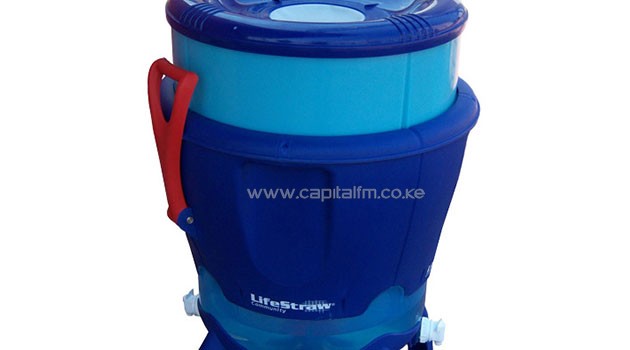
The LifeStraw Community water purifiers donated by Lamb Replenish, an American based NGO and distributed through, Radbone Clark will be taken to the schools as part of an elaborate strategy to promote public health standards/FILE
The LifeStraw Community water purifiers donated by Lamb Replenish, an American based NGO and distributed through, Radbone Clark will be taken to the schools as part of an elaborate strategy to promote public health standards.
Manufactured by Vestergaard Frandsen, a Swiss based European company specialising in disease control products, LifeStraw Community water purifier are increasingly gaining popularity as effective tools in the fight to reverse the global health crisis associated with lack of safe drinking water.
Speaking when he confirmed the supply deal, Radbone Clark Managing Director Rajen Patel said the new LifeStraw Community water purifier units have a capacity of providing 25 litres of clean potable water and is ideal for public schools, health and community centres. The purifier has the capacity to filter enough water for 50 to 75 children per day for routine consumption.
“The availability of LifeStraw Community products in the Kenyan market and their active usage in Homa Bay County will provide a cost effective platform for rolling back water borne diseases,” Patel noted. “Whether at the wokplace or schools, provision of safe drinking water is now a key concern as it also impacts heavily on national economic development. In schools, provision of safe drinking water can reduce absenteeism largely driven by typhoid, cholera and diarrhea incidents,” he added.
UNICEF Kenya estimates that only 37 percent of schools have access to safe drinking water within 200 meters of school grounds. Drinking contaminated water at school causes illnesses and absences which hinder a child’s ability to receive a proper education. According to UNICEF, a comprehensive program of safe clean water in schools can result in a 42 percent education in absenteeism.
Similar units to those supplied to Homa Bay County have gained popularity in America, Asia, part of South America and the rest of the world as they utilize a chemical free filtration process to purify dirty water. The LifeStraw Community products, he added are also loaded with an inbuilt in safe storage container to hold microbiologically safe drinking water for schools, health facilities, workplaces and community settings.
According to the World Health Organization, more than 3.5 million people die each year from water-related disease and 84 percent of these water-related deaths are in children ages 0 – 14. The WHO estimates the impact of diarrheal disease on children is greater than the combined impact of HIV/AIDS, tuberculosis and malaria.
According to a UNICEF and WHO study, Household water treatment (HWT) interventions may play an important role in protecting public health where existing water sources, including those delivered via a piped network or other improved sources, are untreated, are not treated properly or become contaminated during distribution or storage (UNICEF & WHO, 2009).
Nearly 1.2 billion people in the world lack access to safe drinking water, more than 60 percent of whom live in Sub-Saharan Africa and Southern Asia. Water-borne disease is a leading cause of illness in the developing world.
By employing a hollow fibre filtration technology to convert contaminated water into safe drinking water, the LifeStraw Community product removes parasites, bacteria and viruses. The product is also ranked as one of the solutions that meets the standard for the “highly protective” category of household water treatment options by the World Health Organization and also complies with the US EPA guidelines for microbiological water purifiers.
The LifeStraw Community product has a capacity to purify between 70,000 -100,000 litres of water, enough to serve community settings for several years.









































